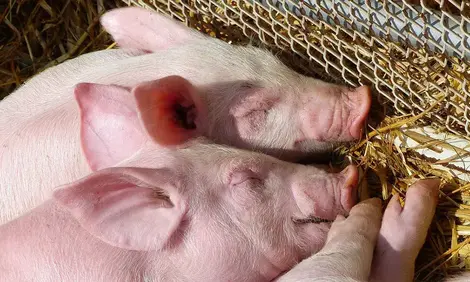



Enumeration of Salmonella throughout the Pork Harvesting Process
Research from Nebraska shows that, while Salmonella were present on the skins of almost all pig carcasses immediately after slaughter, only around six per cent of chilled final carcasses were positive for Salmonella and the majority of those had so few bacteria that they could not be counted.This project provides comprehensive information on the levels and prevalence of Salmonella on pork carcasses during processing to benchmark the effectiveness of in-plant interventions on Salmonella reduction, according to the report's author, Dr Michael N. Guerini of the USDA-ARS-USMARC in Clay Center, Nebraska.
During the course of the project, 190 pork carcasses were sampled over two consecutive days in each of four seasons at a pork processing plant in the United States. Samples were collected at three steps in processing: skin (after ex-sanguination and before scalding), pre-evisceration carcass (after scalding, singeing, and polishing) and chilled final carcass in the cooler.
Overall prevalence of Salmonella on skins was near 100 per cent in all seasons with a one-day low of 85 per cent in the winter. The range of Salmonella prevalence on pre-evisceration carcasses was between 10.5 per cent and 69.5 per cent.
Final carcasses had 12.6 per cent Salmonella prevalence in the summer, undetectable (0 per cent prevalence) in the fall, around 4.2 per cent prevalence in the winter and around nine per cent in the spring.
The prevalence of Salmonella was twice as high on skins and three times higher on pre-evisceration and final carcasses as was expected.
During the four seasons, the lowest enumerable level of Salmonella bacteria on skins was 27 colony-forming units (cfu) on 100 square centimetres and the highest level was 2,322cfu on 100 square centimetres.
Salmonella serotype and drug resistance patterns have been determined for 2,176 isolates.
From this data set, 22 serotypes have been identified and the antibiotic profiles of these range from having resistance to eight antibiotics to being susceptible to all 14 antibiotics tested.
From his results, Dr Guerin concluded that, when the amount of Salmonella on skins was high - as indicated by both a large number of enumeration positive samples and high enumeration levels - the chance of having Salmonella on carcasses was higher. However, the percentage of carcasses with levels high enough to enumerate and the enumeration levels were both relatively low.
October 2013








